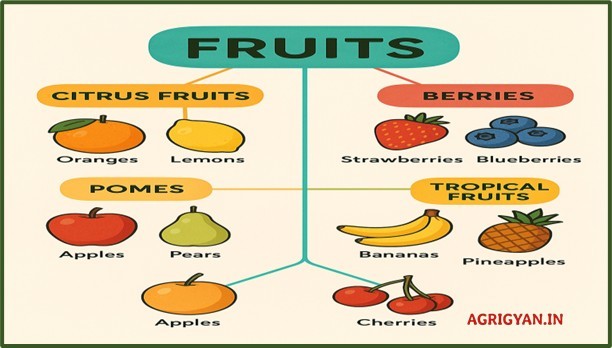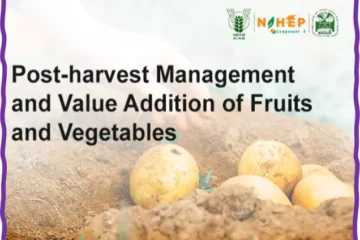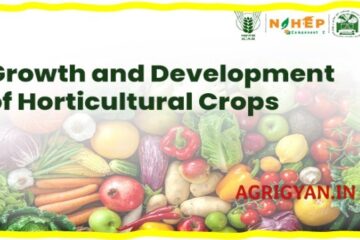This detailed post explores the multifaceted classification of fruits, covering botanical anatomy, climatic adaptability, respiration rates, and post-harvest management. Learn about monocot and dicot distinctions, ethylene production levels, salt/acid tolerance, and morphological subtypes like berries, drupes, and nuts. With tables and examples.
Botanical Basis
Monocotyledonous Fruits : Characteristics : Single cotyledon, parallel leaf venation, fibrous roots, floral parts in multiples of 3.Examples : Arecanut (Areca catechu ), Banana (Musa Paradisica ), Coconut (Cocos nucifera ), Dates (Phoenix dactylifera ), Pineapple (Ananas comosus )Dicotyledonous Fruits : Characteristics : Two cotyledons, reticulate leaf venation, taproots, floral parts in multiples of 4 or 5.Examples : Mango (Mangifera indica ), Papaya (Carica papaya ), Guava (Psidium guajava ), Mandarin (Citrus reticulata ), Sweet Orange (Citrus sinensis ), Lemon (Citrus aurantifolia ), Bael (Aegle marmelos ), Grape (Vitis vinifera ), Pomegranate (Punica granatum ), Phalsa (Grewia subinaequalis ), Karonda (Carissa carandas ), Sapota (Achras sapota ), Litchi (Litchi chinensis ), Apple (Malus domestica ), Custard Apple (Annona squamosa ), Jackfruit (Artocarpus heterophyllus ), Fig (Ficus carica ), Strawberry (Fragaria ananassa )
Classification Based on Climate
Fruit Type Description Examples
Tropical Grown in warm climates
Mango, Banana, Papaya, Sapota, Pineapple, Jackfruit, Cashew, Coconut, Custard Apple
Sub-Tropical Grown in regions with mild winters
Guava, Pomegranate, Grapes, Citrus fruits, Litchi, Fig
Temperate Require cooler growing conditions
Apple, Pear, Plum, Peach, Almond, Walnut, Strawberry, Cherry
Arid Adapted to dry conditions
Ber, Date, Aonla, Bael, Phalsa, Karonda, Jamun
Classification Based on Photoperiodism
Plant Type Light Requirement Examples
Long Day Plants (LDP) 12–14 hours
Apple, Passion Fruit
Short Day Plants (SDP) 8–12 hours
Strawberry, Pineapple, Coffee
Day Neutral Plants (DNP) Light duration has minimal effect
Papaya, Banana, Guava
Classification Based on Salt Tolerance
Tolerance Level Examples
High Tolerant Dates, Ber, Aonla, Guava, Coconut, Bael, Khirni (sapota rootstock)
Medium Tolerant Pomegranate, Cashew, Jamun, Fig, Phalsa
Highly Sensitive Mango, Citrus, Apple, Strawberry, Pear, Avocado
Classification Based on Acid Tolerance
Tolerance Level Examples
Highly Tolerant Bael, Strawberry, Fig, Wool Apple
Medium Tolerant Pineapple, Litchi, Orange, Avocado
Slightly Tolerant Mango, Banana, Papaya, Apple, Kiwi, Citrus
Based on Storage Capacity
Storage Capacity Duration Examples
Highly Perishable 0–4 weeks
Apricot, Banana, Cherry, Fig, Strawberry, Mango, Papaya, Phalsa
Perishable 4–8 weeks
Avocado, Grapes, Orange, Pineapple
Semi-Perishable 6–12 weeks
Coconut
Non-Perishable >12 weeks
Apple, Lemon, Pear
Based on Fruit Morphology
Simple Fruit
Berry: Examples: Banana, Papaya, Grapes, Sapota, Guava, Dates, AvocadoModified Berry:
Amphisarca: Bael, Wool ApplePome: Apple, PearPepo: (Typical of Cucurbitaceae)Accessory Forms: Mango, Ber, Coconut, Phalsa, Karonda, Lahsua, Cherry, Peach, Plum, Coffee, AlmondHesperidium: CitrusNuts: Cashew, Litchi, Walnut, Pistachio, Water Chestnut, RambutaniCapsule: AonlaBalusta: Pomegranate
Aggregate Fruit
Aggregate of Berries: Custard Apple, RaspberryAggregate of Achenes: StrawberryAggregate of Drupe: JamunAggregate of Follicle: (Also referred to as “Catharanthas”)
Multiple Fruit
Type Description Examples
Sorosis Fusion of many flowers forming one fruit
Pineapple, Jackfruit, Mulberry
Syconus Inverted inflorescence forming a fruit
Fig
Based on Respiration Rate (mg CO₂/kg/hr)
Respiration Level Range Examples
Very Low <5
Nuts, Arid Fruits
Low 5–10
Apple, Grapes, Citrus
Medium 10–20
Mango, Banana, Fig, Pear, Peach
High 20–40
Strawberry, Avocado
Based on Ethylene Production Rate (UL C₂H₄/kg/hr)
Ethylene Level Range Examples
Very Low <0.1
Citrus, Grapes
Low 0–1
Pineapple, Watermelon
Medium 1–10
Mango, Banana, Fig, Guava
High 10–100
Apple, Papaya, Avocado
Very High >100
Passion Fruit, Sapota
Based on Fruit Bud Type
Bud Type Description Examples
Simple Bud Fruit develops from a single bud
Mango, Dates, Coconut, Cherry, Peach, Plum
Mixed Bud Fruit develops from a combination of buds
Custard Apple, Guava, Grapes, Pomegranate, Cashew, Pear
Based on Breeding System
Self-Pollination (Autogamy)
Type Key Features Examples
Cleistogamy Pollination occurs within closed flowers
Sapota, Papaya, Grape
Homogamy Male and female parts mature simultaneously
Citrus, Phalsa, Dwarf Coconut
Chasmogamy Fertilization takes place immediately after the flower blooms
Tomato
Bisexuality Flowers contain both male and female reproductive organs
(General feature in many flowers)
Cross-Pollination (Allogamy)
Type Description Examples
Monoecious Male and female flowers on the same plant, but on different flowers
Aonla, Jackfruit, Coconut, Muscadine Grape, Cucurbits
Dioecious Male and female flowers on separate plants
Papaya, Date Palm, Kiwi, Pointed Gourd, Spinach, Beetroot
Andromonocious Male flowers and bisexual flowers occur on different parts of the same plant
Mango, Muskmelon
Androdioecious Some plants bear only male flowers, while others bear only bisexual flowers
Rambutani
Gynomonoecious A single plant has separate female and bisexual flowers
Black Pepper, Banana
Gynodioecious Female flowers are found on one plant, and bisexual flowers on another
Fig, Some varieties of Papaya
Dichogamy The anther and stigma of the same flower mature at different times:
– Protandry: Male parts first (Coconut, Walnut)Protogyny: Female parts first (Banana, Fig, Pomegranate, Sapota)Heterodichogamy: (Pistachio, Pecanut)Duodichogamy: (Chestnut)PDSD: (Avocado)
Heterostyly Flowers have different style lengths:
– Pin type: Sapota, Litchi, PomegranateThrum type: Almond
Self-Incompatibility Mechanism to prevent self-fertilization
– Sporophytic: Mango, AonlaGametophytic: Ber, Apple, Pineapple, Cherry









🎓 Student Discussion
Share your questions and insights with the community!
Loading discussion...